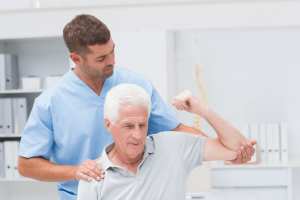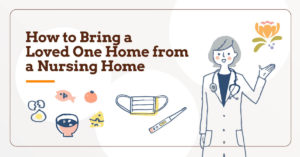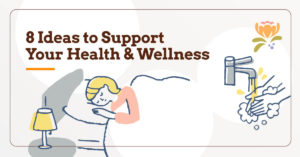Falls are one of the scariest accidents facing our elderly population. And with good reason. Injuries occur most often from falls. Each year, millions of older individuals—those aged 65 and older—fall. In fact, more than one out of four older people fall each year, but less than half tell their doctor. Falling once doubles your chances of falling again due to fear of falling, reducing exercise and increased frailty after recovery from an illness or injury. Falls can result in a wide range of injuries, including cuts, sprains, fractures and head trauma, which includes brain injuries. (source: www.cdc.gov)
Preventing falls is the leading way to avoid being hurt. However, accidents will happen and injuries, from falls and other incidents, do occur. So, what do you do when your loved one is hurt? How is treating an injury in an older person different than those younger in age? Below is information intended to help both the patient and the caregiver navigate an injury and the recovery period. The sites sourced throughout the article are great resources for statistics and prevention measures.
Most Common Injury Types in Elderly
Injuries are frightening no matter if it happens to you or a loved one. It’s important to assess an injury as soon as it happens. If you or someone you care for falls, is in an accident or even feels a sharp pain from a sudden movement, these are the most likely injuries that will need to be addressed.
Bone Fractures
Older adults are at a higher risk of bone fractures than younger people. With age, bones lose their ability to resist cracks, which can eventually cause breaks. Fifty percent of women and 25 percent of men over the age of 50 will suffer from an age-related fracture at some point. Older adults are also at risk for osteoporosis, defined as a loss of bone density. Fractures can develop in any bones, but hip fractures are of significant concern for the elderly population with more than 300,000 hospitalizations occurring each year. (source: https://www.nof.org)
Seniors can reduce their risk of fractures by getting enough vitamin D and calcium, avoiding excessive drinking and smoking, exercising to improve balance and strengthen bones, and using a cane or other walking assistance device.
Sprains
Sprains are often associated with physical activity, especially in someone younger. But they are not limited to trauma in sports. Over time, the tissues of the joints wear down and become less flexible, which increase the risk of a sprain. Wrist sprains often happen when someone puts their hand down to catch themselves during a fall. Ankle sprains, on the other hand, can be from simple actions like standing up out of a bed or chair, often with a misstep or when not fully balanced.
Many of the precautions mentioned for preventing fractures also help prevent sprains. Eating foods and taking supplements, like multivitamins, that help reduce inflammation and speed up the body’s healing process may be beneficial after a sprain occurs. And don’t forget to ice a sprain immediately!
Head Trauma
Head trauma is another common injury among seniors, and very scary whenever it happens. Some head injuries are superficial, but others are very serious. It is important that ALL head injuries be evaluated by a medical professional. Traumatic brain injuries (TBIs), which include concussions, impact those over the age of 75 more than any other age group, with a significantly higher rate of hospitalization and death. Almost half of TBIs are caused by falls. Many times a fall causes a head trauma because the older individual can’t control themselves during the fall due to lack of strength or reflexes. Car accidents are the second most common cause of TBIs. (source: www.brainline.org)
One of the best ways to prevent head trauma in seniors is to get rid of clutter and objects like loose rugs that could be a tripping hazard. Arranging transportation for seniors who are no longer able to safely operate a car will also decrease their risk of sustaining a TBI in an accident.
Shoulder Dislocation
 Shoulder dislocations can be caused in several ways, including falling on an outstretched arm, repetitive use from activities like tennis or golf, and overextending when reaching for an object. Caregivers should also take great care when helping seniors move because shoulder dislocation can happen when someone is pulling on a person’s arm to help them stand up. Proper training in how to move someone with limited mobility should be given to any caregiver to help eliminate this risk.
Shoulder dislocations can be caused in several ways, including falling on an outstretched arm, repetitive use from activities like tennis or golf, and overextending when reaching for an object. Caregivers should also take great care when helping seniors move because shoulder dislocation can happen when someone is pulling on a person’s arm to help them stand up. Proper training in how to move someone with limited mobility should be given to any caregiver to help eliminate this risk.
To prevent shoulder dislocations, seniors should work on improving the range of motion and mobility of their shoulder. They should also work to strengthen the muscles of the shoulder joint to help protect it from injuries. Rearranging cabinets can be helpful, too, to reduce the need for seniors to overexert themselves when reaching for objects.
Elevator Accidents
While elevators are widely viewed as a safer alternative to stairs or escalators, a study published in 2010 found that they are a common site for accidents and injuries among elderly people. Thousands of older Americans end up in the emergency room every year due to an elevator-related injury, most of which are caused by a slip, fall, or trip. Roughly one-third of elevator-related injuries are caused by the door closing on a senior, and about 40 percent of ER admissions for elevator-related injuries were due to hip fractures. The best way for seniors to avoid getting hurt in or near an elevator is to avoid rushing and, if possible, having someone hold the door. (To read more about elevator risks and safety, visit http://www.todaysgeriatricmedicine.com/archive/082510p8.shtml)
The Difference in Injury Recovery for Older Adults
Older people may have a slower recovery from injuries compared to their younger counterparts.
Physical changes that occur in the body as we age can slow normal responses in the immune system or blood clotting in older people. Skin and muscles become thinner with age and bone strength may be weaker. These age-related changes may delay healing and leave the older patient prone to other problems such as infection or chronic pain.
Healing from injury also can be complicated by other diseases. Many older people have other health problems, such as high blood pressure, heart disease, diabetes or dementia which can complicate or slow recovery after injury. This can be due to the disease itself or the medication taken to treat the disease. Some older patients take medicines on a daily basis such as aspirin, warfarin or painkillers, and these may affect the time it takes to heal after trauma. Anyone taking blood thinning medications, such as warfarin, should seek medical evaluation after any injury, even one that may seem minor, because of potential blood clotting issues and internal bleeding that may not be immediately noticeable.
A final complication that can delay recovering from an injury is lingering chronic pain. It is difficult to concentrate on rehabilitation when there is pain in the body. Having a plan in place with a doctor is important for long-term pain management so setbacks are less likely to occur.
Have Patience
The most important thing for both caregivers and individuals to remember is to be patient and allow a body time to heal. Rushing through physical therapy, continuing to use an injured body part or stopping treatment prescribed by a doctor will only delay the recovery process and can cause long-lasting medical problems.
Assisted Living Services provides qualified in-home caregivers to help manage injury recovery. Please contact us if we can answer any questions.
Photo from westernberkspt.com






2 Responses
Many of those injuries occur when transferring from bed to wheelchair and vise versa as well as toilet transfers. The AgileLife Mobility System is a safe zero lift transfer device that prevents injuries to individuals on both sides of care.
I generally rely upon the versatility framework. Versatility System is a protected zero lift move gadget that forestalls wounds to people on the two sides of care. A significant number of those wounds happen while moving from bed to wheelchair and tight clamp versa just as latrine moves.